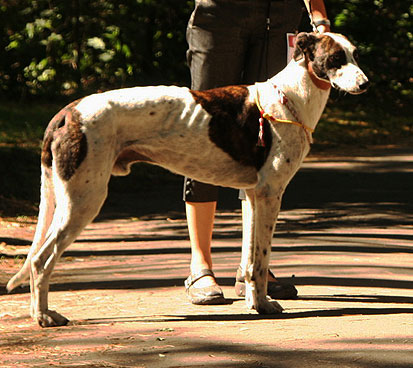Breed History
BY TOM KOLER
The Magyar Agár is a long distance racing hound. He was bred to be a dispatcher of game shot by horseback riders on an open plain or open stand of hardwood timber. The Magyar Agár was expected to accompany the hunters for distances of usually 30 kilometers (19 miles) and up to a maximum of 50 kilometers (31 miles) in a day. The game in most cases was hare and deer. Through most of Hungarian history the Magyar Agár was not solely owned by the nobility. Every Hungarian, if he so wished, could own and hunt with an Magyar Agár. Although the Magyar Agár was not limited to some cultural or aristocratic status, the Magyar Agárs found with the nobility were much bigger than those of the landed peasants. Magyar Agárs owned by the peasants were known as Farm Agárs or simply as Hare Catchers. These smaller versions of the Magyar Agár are now extinct. Today the Magyar Agár is popular with European racing and show ring enthusiasts who are untiring in their support for this rare breed.

The modern Magyar Agár is a robust and energetic sighthound which resembles the modern English Greyhound. The word agár in Hungarian means gazehound or windhound. For example the Afghan Hound in Hungarian is Afghan Agár. Magyar, of course, is the Hungarian name for Hungary and for the nomadic Eurasian tribe that settled in the Danube River basin in 896 AD. Therefore there is sensitivity among some Hungarians when the Magyar Agár is referred to as the Hungarian Greyhound rather than gazehound or windhound. We will return to this point shortly.
Tradition tells us that the Magyar Agár first arrived in northeastern Hungary and the Great Alföld (Hungarian Plain) a little over a thousand years ago. Although they have lived throughout the Great Alföld, they have had a strong hunting history in the three counties of Szabolcs-Szatmár-Bereg, Hajdû-Bihar and Somogy.

The breed has always been popular with Hungarians it is not uncommon to hear about their memories of the Magyar Agárs. For example, one native Hungarian fancier recalls spending her childhood summers in a small country village where Magyar Agárs roamed the streets and fields. As she says, these were true socialist hounds during Hungary’s socialist era; they belonged to no one and they were free for the taking. Every day a grandpa, uncle or father would grab one or two Magyar Agárs and off to the fields and woods they would go to hunt for hares and thereby provide meat for that evening’s meal. In addition to being available for hunting, the village Magyar Agárs were remembered as gentle hounds that stayed close to young children as the children played.
The Magyar Agár is, historically speaking, a breed with a history that is eleven hundred-years old. There are oral histories that indicate that the Magyar Agárs were with the Hungarians (i.e., Magyars) much earlier when this nomadic tribe lived in the Ural Mountain Range of Eurasia. But there is currently no empirical evidence to help prove this hypothesis. The earliest archeological evidence for the Magyar Agárs has been found in the Carpathian Mountain Range located along the northern and eastern Hungarian border.

Historians have a good perspective of the Magyars and in a sense the Magyars were the Hell’s Angel’s of the early Medieval Age. The Agárs by association with these mercurial nomads were part and parcel of the Magyar’s reputation. The following quote from Johnson (1996) gives us a perspective of the cultural environment that the early MAs lived in:
“The Magyars, a nomadic tribe that made its debut in Europe in 896 AD by spilling over the Carpathian Mountains onto the Hungarian Plain, were a wild and recent addition to Central Europe’s collection of peoples. With distant roots somewhere in the depths of Central Asia, these combative nomads spoke a language from the Fino-Ugric family that was incomprehensible to their neighbors. Their eventual settlement on the Hungarian Plain in the central Danube Basin…took the Magyars quite some time to abandon their nomadic ways.”
Johnson’s description of the Magyars can give the impression that their livestock and hounds needed to be able to depart at a moments notice. The horse used by the Magyars when they first arrived was technically a pony from the Eurasian steppes. The dogs that accompanied the Magyars were a variety of oriental breeds that became part of the Magyar horde as it traveled from the Eurasian steppes and into Central Europe. Did the Magyar Agárs exist before the Magyars reached the Carpathians? Currently this remains open to debate. With time the horse evolved into the Hungarian Horse and the Magyars became the premier cavalrymen of Europe known as the Hussars. The Agárs conformation from the Medieval to the Modern Age has remained the same until the introduction of the Greyhound in the 1800s. To the Hungarians the Hungarian Horse, Hussars, and Magyar Agárs are interconnected through their rich history.
In summary, the Magyar Agár is a breed from Hungary with an eleven hundred-year history. This large gazehound when compared to the greyhound has a heavier musculature, thicker coat, longer than taller body, longer tail and a larger head with floppy ears. The Magyar Agár has been used by Hungarians of all different social-economic strata ranging from the nobility to the landed peasant. Its primary role in life until modern times was to dispatch hare and deer for hunters on horseback. Hunts were typically 30 to 50 kilometers and the Magyar Agár was expected to keep pace with the horses. These are truly rugged long-distance sighthounds.
